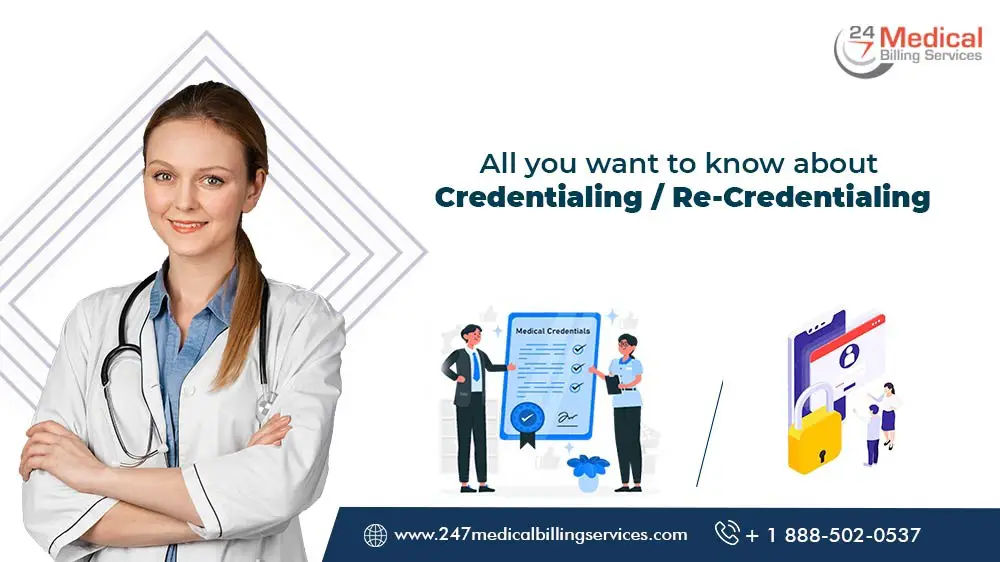Whenever any healthcare facility hires a new healthcare practitioner, such as a nurse, physician, or any other new healthcare staff, they must undergo a credentialing/ re-credentialing services. Credentialing is the process that allows the medical facility to verify the skills, qualifications, and other credentials listed, along with getting approval from the medical insurance providers with whom your facility works often.
However, if you think credentialing is done once the payer’s network accepts them, then you are wrong. Mainly, when it comes to healthcare providers, they have to undergo regular screening and verification to warrant that they comply with federal and state medical guidelines and comply with them. Screening and verification are also accompanied to ensure the providers can give quality care to the patients. Such a process of regular screening and verification is known as re-credentialing.
Why Credentialing/Re-Credentialing Is Important?
For any healthcare facility to ensure that their insurance claims are processed properly and get them successfully, the healthcare providers need to undergo successful credentialing. Furthermore, credentialing is vital if any patient is uninsured or gets treatment/service for which they must pay from their pocket.
Apart from credentialing the physicians, it also needs to be done for the following:
- Health and hospitals agencies
- Physical therapists
- Dentists
- Counsellors and psychologists
- Licensed massage therapists
There are several guidelines that healthcare facilities need to follow for credentialing and re-credentialing process so they can accept Medicaid and Medicare services. The federal agencies whose guidelines for the facilities need to follow and meet for credentialing/re-credentialing are:
- The Joint Commission on Accreditation of Healthcare Organizations
- Centre for Medicare and Medicaid Services (CMS)
Apart from the federal agencies, the facilities also have to undergo state credentialing—all these point to the fact that credentialing and re-credentialing is a tedious and time-consuming process. But simultaneously, any wrong step can become a problem for the entire facility.
How To Ensure Proper Credentialing/Re-Credentialing?
A few steps can be followed to ensure that credentialing/re-credentialing is done correctly and on time so your healthcare facility can run without hassle while providing the best patient services and treatment.
1. Documentation
The first part of ensuring the credentialing/re-credentialing is done correctly and has hassle-free progress understands the different documentation and forms each insurer needs. You must submit a complete and correct application with the credentialing/re-credentialing form to each insurer with whom you want to work. You can start by making a list of documents required by the insurance providers:
- Name
- Demographic information
- Social security number
- Education and residency information
- License proof
- Career history
- Patient focus and specialties
- Insurance proof
- Information on your healthcare establishment
The insurance agencies can require other information for credentialing/re-credentialing. Hence, read the requirements carefully, prepared the documents, and submitted them.
2. Prioritizing Insurers
Since there are several insurance agencies and for credentialing/re-credentialing, you have to submit documents separately. Prioritizing the insurers and sending your applications to them first is better. You can follow these steps for prioritizing:
- Complete the credentialing/re-credentialing application first for the insurance company through which a significant portion of the medical billing goes through
- Look into insurance companies that offer quick approval and streamlined process, and target them for credentialing/re-credentialing first.
- Insurance providers offering an abbreviated application for in-state credentialing/re-credentialing are an excellent option.
3. Information Accuracy
As you start with filling out the credentialing/re-credentialing of the forms and application and preparing the documents, remember to check them because accuracy is the key to getting successful credentialing. The following steps can be followed to ensure information accuracy:
- Background check and verify the documents of practice, board certification, education history, etc.
- Review credentialing history
- Check if the Office of Inspector General has ordered any sanctions
The verifications can be done manually or through other methods. Manual checks and verification are time-consuming and expensive at the time; hence, using different methods like credentialing software or outsourcing can be a good option for the first turnaround.
4. Check Whether CAQH Is Required?
Applying through the Council for Affordability Quality Healthcare is required by major healthcare insurers. Check if the insurance agency you are applying for credentialing demands such a requirement. If the insurance company partners with CAQH, then a CAQH number has to be mentioned while submitting the application to the insurer for credentialing/re-credentialing. You will then be required to complete and submit the CAQH form. Thereby, any error can delay or reject the CAQH approval. Finally, you must re-attest after the submission, which means the information provided is correct.
5. Follow Up
It has been established that there are better ways to move ahead than sitting ideally for the credential/re-credential approval to come. Following up on the submitted credential/re-credential forms is the key to getting a quick response. It can be done by establishing contact with a knowledgeable person from the insurance company and then checking via email or phone to increase the turnaround time. It also will allow you to know if any additional information is needed, which you can provide without getting the application delayed or rejected.
Are you tired of doing the credentialing/re-credentialing?
Are you tired of dealing with insurance companies regarding credentialing/re-credentialing? In that case, there is an easy solution – partner with credentialing/re-credentialing specialists such as 24/7 Medical Billing Services. They will do the credentialing, keep in mind when re-credentialing is required, and do all the laborious documentation, checks, and verifications that adhere to the ever-changing terms of insurance companies. It will also allow you to focus on your practice and provide the service while the credentialing experts do the other work for you.
Read more: Everything DME Providers Need To Know About Credentialing & Re-Credentialing
0






